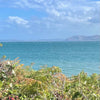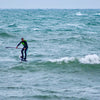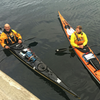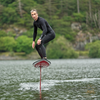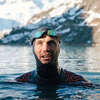Successful SUPing
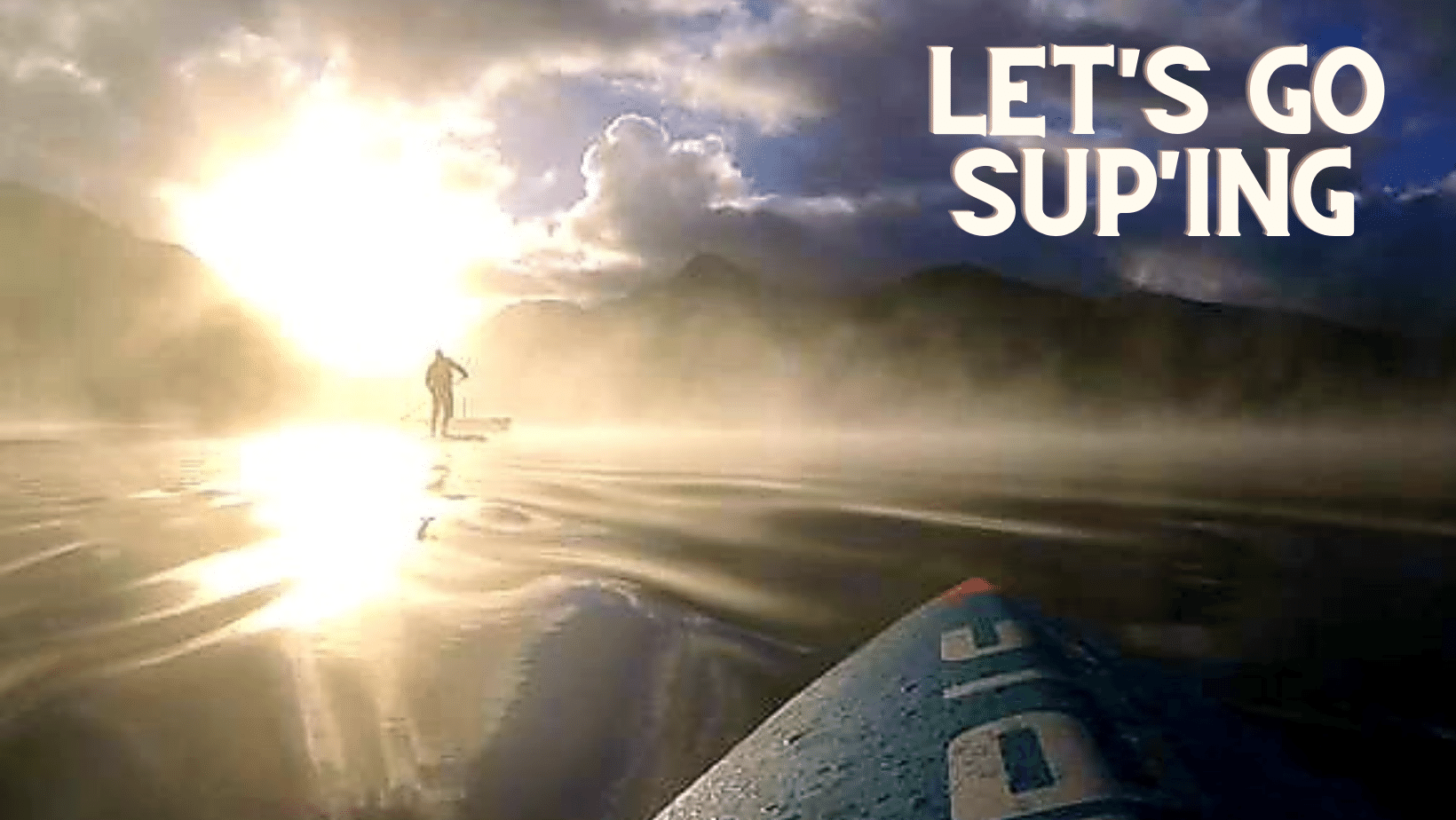
Safety advice and progression in paddleboarding
Section one includes some general information worth considering to keep you safe and make your SUP sessions more enjoyable. If you’ve been successfully paddleboarding for a while you may want to scroll to section two which aims to provide some ideas about developing your SUP skills and paddling in more dynamic environments.
Section 1 - First timers and newbies
You’ve gone and done it, you’ve just bought your first iSUP, (inflatable stand up paddleboard) and your chomping at the bit to get it wet. With the right approach you’re likely to have hours of fun while you paddle around enjoying being outdoors on, (and possibly in) the water. But before you get carried away with loading up your kit, the dog and a GoPro there are some pretty important factors to consider. Read on to make sure you stand the best chance of maximising your efforts.
Planning
It might sound a bit boring but without a sensible plan you run the risk of getting to your chosen venue and either not getting on the water or more worryingly launching yourself onto the water and getting into difficulty. Planning starts before you leave your house in the days leading up to your paddle.

Venue selection
How are you going to get there? What are you going to do with your kit while you’re on the water? Do you need permission / access agreement to use the venue? What are the dangers of paddling at the venue? Consider currents, tides, wind, weirs, waterfalls, waves, rocks, structures, motor boats and jet skis. Are you going to start and finish at the same point? If you’re going to start and finish at a different location will you need to arrange transport? What affect will the weather have on your chosen venue?

Weather forecast
Wind - which way is the wind forecast to blow and how strong will it be? As general rule, if there are any white capped waves progress will be very difficult or impossible. White capped waves are likely when the wind speed exceeds 10mph. Will the wind blow you away from safety or towards a hazard? What affect will the wind have on your chosen paddling route? Is there any way you can safely use the wind to your advantage?
Sunshine - while paddling in sunny warm conditions is most peoples preference it’s worth making sure you are prepared for potentially long periods of exposure to the sun, this means covering up with appropriate clothing including headwear and sun glasses. Wear suncream. Carry plenty of drinking water.
Rain - fortunately a bit of rain isn’t the end of the world when you're on your paddleboard, but be wary of excessive rain and understand what affect it is likely to have on your paddling venue and route. Are you likely to experience unexpected currents or additional hazards if the water level suddenly rises? Paddling on rivers which are swollen from rain should be avoided due to the additional risks you are likely to encounter.
On the day - Thanks to the various weather forecasting sites it’s possible to gather a wealth of information in the days leading up to your paddle, but remember, weather forecasts aren’t always 100% accurate. On the day of your paddle and while you're on the water ask yourself, is the forecast correct? If the weather on the day isn’t what was forecast you may need to adjust your route and your equipment.

Equipment
If your kit is brand new it’s a good idea to set everything up at home before your paddle, that way you can make sure you have all the various bits and pieces you need and can get rid of any excess packaging. The clothing you choose to wear should take into account the weather and the likelihood of you ending up in the water. Neoprene leggings, longjohns and wetsuits are great if you’re likely to get wet. Remember that the water temperature will always feel cold even during hot summer days.
Buoyancy aids are recommended at this stage of the game. It’s worth looking out for a slimline, low profile buoyancy aid as it will be easier to jump back onto your board if you end up falling in.
A waterproof mobile phone case gives you the option of taking your phone with you on the water which means you will be able to take pictures and if necessary contact someone on land if your plans change. It also gives you the potential to call in an emergency if something disastrous were to happen.
Drybags are the best way to carry any food or equipment with you while you paddle. They are relatively affordable and can be attached to the deck of your board for easy access while on the water.
Other people
Paddling with friends offers a degree of increased support and security. The psychological benefits of taking part in outdoor activities and exercise with close friends can only be encouraged. If you are paddling as part of a group you should be aware of the skill levels of the other group members and make sure everyone in the group is happy with the route and the way the group is being controlled. Be careful about making decisions on behalf of the group.
Communication
Within a paddling group it is important to maintain communication with each other. This can be achieved in a variety of ways including verbally and by using hand signals. Staying within sight of one another is a useful way to assess how everyone is getting on.
Whether you're paddling in a group or by yourself you should ensure your planned route and timings are left with someone on the land. It’s worth making sure that the person knows your plan and how you will let them know you’re safely off the water and also what to do if they need to raise the alarm.

In Summary
-
Plan your paddle
-
Assess the hazards
-
Dress appropriately
-
Use appropriate equipment
-
Communicate with others
-
Prioritise Safety
Section 2 - Developing your paddling
You’ve been paddling for a while now at one or two of your favourite venues and have experienced a range of weather conditions. You’re happy with the kit you have and can use it effectively. You’re now at a stage when you feel like you need a new challenge but you’re not sure what to try.
A primary consideration is the equipment you have and it's suitability for your new goals. Some basic general purpose paddleboards have a fairly limited potential when it comes to paddling on anything more than sheltered flat water. If your board is excessively flexible it will make life much harder for you as you move in to different environments. On the other hand if you invested wisely on a good quality general purpose paddleboard you should be able to use it up to a certain level across a range of disciplines from the sea to rivers and lakes. Making sure the equipment you have is suitable for the activity and provides you with the potential to learn new skills is a fundamental consideration at this stage.

Surfing - SUP surfing has been around for years in one form or another. There are plenty of advantages to surfing a SUP, waves don't necessarily need to be big and powerful plus they are much easier to catch. You’ll generally stay warmer than prone surfers as you will be out of the water for longer periods of time. iSUPs can be used for surfing which makes getting to and from surf locations relatively easy. A good quality iSUP with a stiff construction will catch waves easily and allow you to ride them all the way to the beach. Alternatively there are purpose build composite SUP surf boards that have been shaped specifically to perform in the waves. The benefits of a hard board over an iSUP when you’re on the water are all to obvious, the board will be more responsive and you’ll be able to turn and generate more speed than if you were surfing an iSUP. The downside is that hard boards are a bit more delicate and there are additional considerations to transporting and storing a hard board.

Additional considerations. If you don’t live near a coastline with suitable waves how much water time are you likely to get on a dedicated surf SUP? A general purpose board that can be used on flat water as well as in the sea may be a better option or alternatively you may consider a large surf SUP that can be paddled on flat water.
Paddling a large SUP in waves creates additional hazards to you and to other people in the water so it is really important that you consider other surfers, understand surf etiquette and ideally select venues that are not crowded.

SUP Touring - As a method of travel, paddling from A to B goes back thousands of years and is still relied on by many people even today. From a recreational point of view the process of propelling yourself across a body of water can be extremely rewarding. The sights and sounds you notice from the water are often totally different to anything you find on dry land. Having the skills, ability and the right equipment to explore a coastline, a large lake or even a meandering river are key to a successful trip.
Recreational SUP touring, in reality is an extension of general purpose paddleboarding, while there are some specialist bits of equipment designed with touring in mind it is possible to use much of the same kit you would use for a general purpose paddle. A good quality general purpose iSUP works as a short distance touring board. The clothing you wear and the safety equipment you use on a general paddleboarding session will all be relevant to a short touring trip which means getting into SUP touring is quite straight forward once you have some basic kit and some water safety awareness.

Start easy - To begin your SUP touring development it would be sensible to identify some straight forward day trips which provide lots of flexibility and easy escape options. A couple of good examples include paddling along a section of canal or around the shoreline of a lake. Venues like these allow you to build up planning skills and paddling experience without exposing yourself to more hazardous environments. In planning the trip you will need to include all the factors mentioned in section 1 of this article. As you paddle your fitness and technique should improve. At the same time your personal administration will evolve and you’ll work out how to stay comfortable and how to eat and drink while on the water.
Progression - Once you’ve successfully carried out a few day trips at a variety of locations the natural progression would be to find more challenging trips. These could include longer distance or multi day trips or maybe paddling on more technical stretches of water. Coastal journeys that involve dealing with wind, tides and waves or maybe a long flowing river with graded sections of water would potentially provide a suitable challenge.

At this stage, the kit you’re using will make a bigger difference to your paddling experience. Some paddleboards are designed specifically for covering long distances while carrying additional equipment. Touring SUPs often have a different outline and profile which makes them more efficient while paddling meaning you’ll cover greater distances with more ease. Transporting and using camping equipment could be a whole new challenge if you’re planning to do multi day expeditions. The more challenging your trip is the more planning you will need to include. Greater challenges inevitably mean increased risks but with a sensible approach and good planning the rewards will be worth it.
SUP Racing - Once you’ve mastered the basics of standing up and paddling it’s likely that you’ve had a go at paddling fast, whether that’s against a friend or against a watch. If you were using a general purpose iSUP you probably reached your maximum speed quite quickly and struggled to maintain it for very long, this is because general purpose iSUPs are pretty inefficient when it comes to paddling fast. This is why SUP racing boards have evolved. Usually 12’6 or 14’ long and varying in widths form 19” to 26” the additional length and reduced width combined with the pointy nose means they move through the water with far less resistance than any general purpose iSUP. While it is possible to race a general iSUP you will achieve a better time and potentially a higher position if you jump on to a racing SUP.
Races - There is a healthy UK SUP racing scene which caters for a wide range of competitors across all age categories at a variety of locations across the country. Often events include “leisure fleets” which allow paddlers to complete the course but who don’t necessarily want to race against others. Race courses are often advertised as technical or flat water meaning you can find an event that suits your preferred style. There will usually be a level of safety cover for racers which means its normally just a case of turning up in good time and paddling as fast as you can. At most events paddlers will receive some form of completion medal or goodie bag with podium places awarded to the fastest paddlers. Designated races will also be used as selection races for national teams with the potential for the fastest racers to compete for their country on an international stage.

If you decide to take SUP racing seriously you will need to invest in a dedicated SUP race board and paddle. If you’re racing on flat water you will probably only need gym clothing and maybe a buoyancy aid. If you’re racing on the sea you will potentially need to include some sort of technical neoprene clothing. Other than that the amount of kit you need is quite small. Depending on how seriously you take it you may get involved in some structured training which is a great way to stay fit and increase your paddling time.
Other SUP disciplines you might be interested in include white water SUP, wind SUP, SUP yoga and SUP foiling. If you want more information about any of the above please don’t hesitate to give us a shout.
Please note
This article is intended for informational purposes only and does not replace the requirement for paddleboarders to take responsibility for their own actions. We accept no responsibility for any accident or injury sustained by paddlers who have based their paddling decisions on this article.
Paddleboarding involves inherent risks which you will need to understand and address to keep yourself and your group safe. If you are in any doubt you should book yourself onto an appropriate course at an approved centre or employ the services of a qualified and experienced paddlesports / SUP instructor.
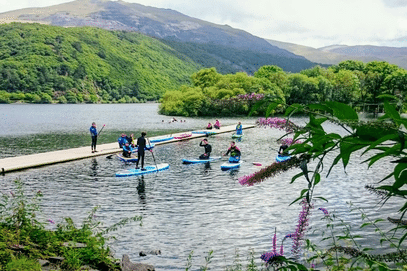
-
Posted in
advice, isup, paddleboard, red paddle co, safety, starboard, sup, surfing, touring
